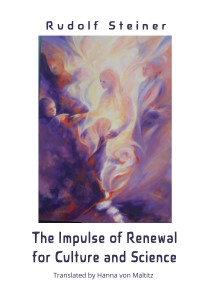The Impulse for Renewal in Culture and Science
GA 81

Here is a First Edition English translation of a series of seven lectures, entitled, The Impulse for Renewal in Culture and Science, published in German as, Erneuerungs-Impuls fuer Kultur und Wissenschaft. This course was organized by the Federation of Anthroposophical University Work and the Berlin Branch of the Anthroposophical Society. It was the aim of the organizers, through lectures by various speakers, to “give an impression of what suggestions in various fields can be given by anthroposophy.” For each course day, Rudolf Steiner gave the introductory lecture. In these lectures, Steiner explains the relationships between Anthroposophy and the natural sciences, philosophy, pedagogy, theology, the social sciences, and linguistics. He also brings to light the biological differences between humans and animals from an anthroposophical perspective. Translated by Hanna von Maltitz
| I. | Anthroposophy and Natural Science | March 06, 1922 |
| Natural Science: application of methodology from inorganic nature to other fields; Anthroposophy: Metamorphosing the concepts. Natural science: rationalistic, anthroposophic: phenomenological conception of nature. Goethe and Ernst Mach as phenomenologists. Causality statements after mathematical conceptualization. Goethe's idea of the “Urpflanze”. Phenomenological “reading.” Anthroposophy recognizes the justification of mathematical causal thinking, but not as the only possible system of concepts. Atomism. – Reflection of the outside world in man, mental-spiritual and material. | ||
| II. | The Human and the Animal Organisation | March 06, 1922 |
| Morphological relationship between humans and animals; Goethe's discovery of the intermediate jawbone in humans. Upward metamorphosis from the animal organization to the human. – Biological differentiation of humans and animals; sensory life as an example. The twelve senses of man. To be placed in the cosmos of human and animal organization: vertical or horizontal position of the spine. – Human sensory perception and the following ideas; vision as an example. Sense of balance and mathematical ideas. What is effected in the physical organization of man by his animal-different state of equilibrium? | ||
| III. | Anthroposophy and Philosophy | March 07, 1922 |
| Different experiences of philosophy earlier and today. Today to distinguish philosophy of the West, the Middle and the East. – West: Herbert Spencer: Orientation to the natural sciences. Strict separation of science and the religious beliefs of the individual. Middle: Hegel: union of mental and sensory world, of faith and knowledge. Hegel's stay in the abstract as tragedy; his logic as a germ to experience the thought as reality. East: Vladimir Soloviev: Experience in spirituality. Use of western terms as an illustration for the mystical experience. – East: philosopher as priest, west: philosopher as world man, middle: philosopher as teacher. – Unconscious adoption of western scientific thinking in Central Europe in the 19th century. No training of concepts in the West, thereby loss of concepts in the middle. – West: Scientific results as a world question. Middle: piercing to the thought at Hegel. East: Looking to what lives above the thought. – Bridges between West and East through anthroposophy. | ||
| IV. | Anthroposophy and Pedagogy | March 08, 1922 |
| The effect of anthroposophic ideas on the whole person. – speculations about the connection between the spiritual and the physical of man in psychology. Application of scientific principles in a metamorphosed way in the anthroposophical view of man. Relationship between the spiritual and the bodily in the child: imitative principle in the first epoch of life, principle of authority in the second. – Unsatisfactory educational methods as a result of abstract intellectualism. Reading the learning plan and learning objective in the development of the child in Waldorf education. – Intellectualism in the third epoch of life, after sexual maturity. – Intellectual cultural impulse in our age; the resulting problems in understand the full human nature of the child and adolescent. Bridge from adult to child world through anthroposophy. – On dealing with the artistic and intellectual in Waldorf education. About the mind of the teacher. | ||
| V. | Anthroposophy and Social Science | March 09, 1922 |
| The “basic issues of the social question:” demand for a threefold division of the social organism; Impulses instead of utopian ideas; Misunderstanding of the book by economics theorists and practitioners. – Instinctive management of economic life in older cultures and its penetration with intellectual ideas since the 15th century. Two currents: economic theoretician, without influence on the practice, business practitioner, remaining in the instinctive. A kind of synthesis of the two in today's economic-scientific realism, resulting in the socio-political legislation. Woodrow Wilson as an abstract theorist. Through anthroposophy, living social impulses instead of abstract intellectualist ideas. | ||
| VI. | Anthroposophy and Theology | March 10, 1922 |
| Discussion of a note in a theological journal. Fundamentals about the relationship of anthroposophy to theology and religion. Anthroposophy as a field of work and research method. – Father God concept was given to men in ancient times. Atheism as a disease. Understanding of the Christ event and introduction to the Christ experience through anthroposophy. Not finding the Christ as a destiny of disaster. Not to the spirit come as mental limitation. | ||
| VII. | Anthroposophy and the Science of Speech | March 11, 1922 |
| Conscious- and subconscious-ness of language. Language as an object of scientific observation. About a parallel speech before English-speaking and other listeners: sensory nuances towards “duty” and “duty.” Language as a nuance of the folk soul. – Different language life in different time periods. Sanskrit as an example: the experience of the word manas; Consonants: restrained gestures, metamorphosed replicas of the external world, vowels: born out of sympathy and antipathy; the infusion of fantastic imaginations into the language. – I-feeling in different times. The spiritual experience of language in the West, in the middle and in the East. – Wilhelm Wundt and his theories about the origin of language. | ||

